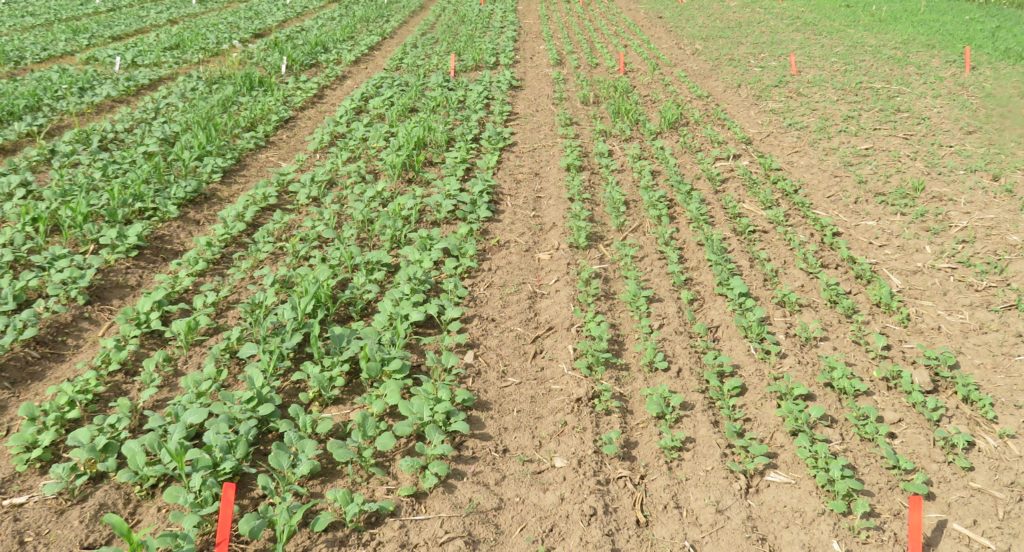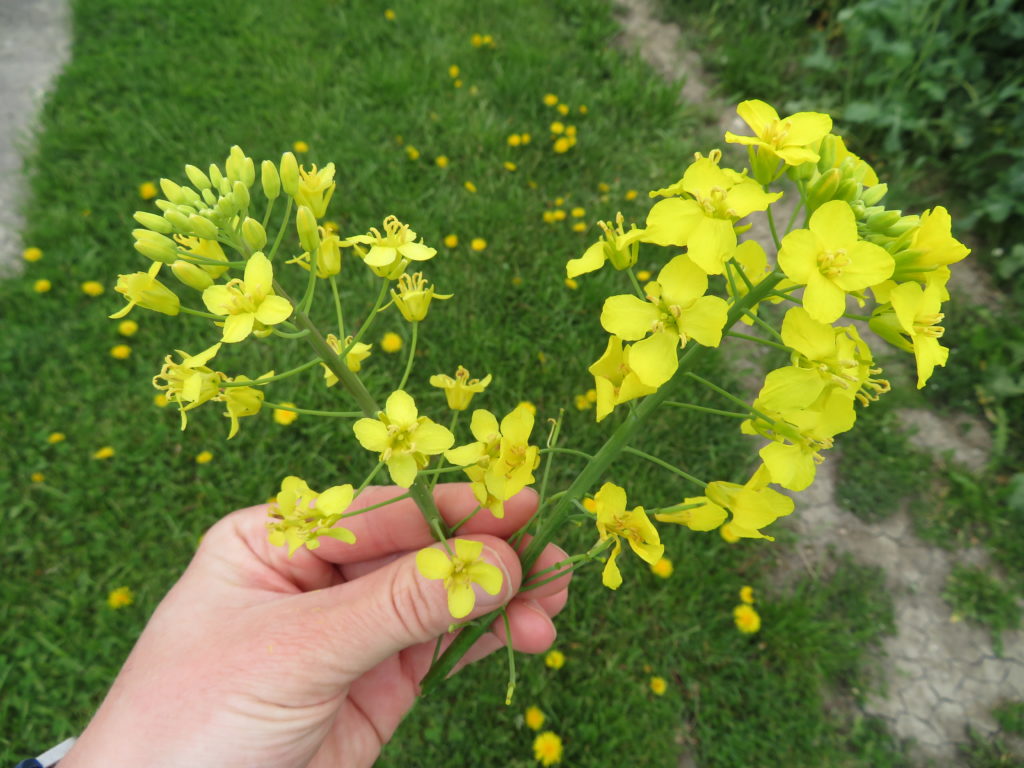Winter canola acres in Ontario have been increasing since 2018. While research on the crop has been limited, some recommendations are outlined below based on experience with the crop in recent years and experience with spring canola in Ontario.
Field Selection
Fields should have good drainage and low clay content. Seeds may fail to emerge with wet conditions after planting, and plants will rot in wet areas in the fall/winter and spring. Heavier soils are also prone to heaving which will kill plants or significantly reduce yield potential. Lower yields have been observed on clay soils, even when winter survival was adequate.
Winter wheat is generally better at overwintering than winter canola. If winter wheat survival is poor on a given field, canola survival will likely be worse. Some producers have had success with canola on fields that tend to dry out in summer causing other crops to suffer. Milder winters and relatively dry springs have tended to result in better overwintering success.
Herbicide History
When selecting a field, review herbicide records for the past two years and check rotational restrictions for canola. Herbicide plant back intervals for canola that exceed two growing seasons include:
• 22 months: atrazine; imazethapyr (e.g. Pursuit); metribuzin (e.g. Sencor)
• 26 months: flumetsulam (e.g. Broadstrike RC)
Winter wheat herbicides with restrictions to canola:
• 1 month: 2,4-D; 2,4-DB; Achieve Liquid; bromoxynil (e.g. Pardner); bromoxynil/MCPA (e.g. Buctril M); MCPA
• 2 months: Boost; Express SG; Refine SG; Refine M
• 4 months: Truslate Pro
• 10 months: Barricade M; Enforcer M; Eragon LQ; Infinity; Infinity FX; Pixxaro; Prominex; Trophy; Valtera EZ
• 11 months: Simplicity GoDri; Varro
Herbicide application options prior to planting winter canola are somewhat limited. The primary choices are glyphosate, glufosinate (Liberty), clopyralid (Lontrel) and trifluralin (e.g. Treflan) as well as grass control products. Eragon and 2,4-D can cause crop injury and should be avoided in pre-plant burn downs.
Consult the OMAFRA Crop Protection Hub for more information. Conventional winter and spring canola (i.e. those without herbicide tolerance traits, such as Mercedes) are the same species and have the same reactivity to herbicides, but not all herbicide labels have information on canola, or on winter canola planting time frames.
Planting Date
Planting date trials have been conducted in Essex County by Dr. Eric Page, AAFC Harrow. The most success was realized with planting in the first two weeks of September. Winter kill and yield losses increase beyond the 3rd week of September, but in a mild or longer fall season the losses with late planting were less extreme. Before winter, plants would ideally have a tap root approaching the width of a pencil and a minimum of 4 to 8 true leaves. However, robust plants with larger roots and crowns will have better survival and will be more vigorous in spring, which may translate to higher yields. Planting early can therefore be advantageous, and as you move north into counties such as Wellington, Grey and Simcoe, planting in late August is recommended. Mercedes has not been observed bolting in the fall, even with August planting dates. As other varieties become available, proceed with caution with early planting dates until information is available on the likelihood of fall bolting.
Based on observations from Dr. Page’s trials, about 600 growing degree days (GDD, base 0°C) are required for adequate growth of canola in the fall. For reference, winter wheat requires about 450 GDD in the fall. The general recommendation is to plant winter canola 10 to 14 days before the ideal winter wheat planting date for your region (see the winter wheat planting date map). Canola survives through winter on its roots, where winter wheat survives on the seed.
More information is forthcoming about Eastern Ontario planting dates based on trials at University of Guelph – Winchester Research Station. Winter canola is not recommended in Northern Ontario due to poor winter survival.
Seeding Rate and Method
Canola can be seeded on 15” rows or narrower. Twin row set ups on 30” centers or 20” row widths may be ok, but rows may not totally close and plants may develop quite large stems. Local research has not been conducted on wide rows.
Seeding can be conducted with drills, airseeders or row unit planters. Each may come with some frustrations because of the small seed and low seeding rate. Seeding rates depend on the expected rate of emergence, which varies with the precision of the seeding equipment. Seed size can vary and this can have a large impact on pounds of seed per acre, so with canola the seeding rates are often somewhat approximated. However, seed is sold based on live seed counts and the retailer should be able to provide you with a target seeding rate in pounds to achieve the proper plant population.
Generally speaking, it is recommended that seeding rates for winter canola be lower than what we typically use for spring canola in Ontario. Winter canola plants need to be more spaced out, so that they do not compete with each other and grow too tall in autumn or “goose neck” out of the ground leaving crowns exposed well above the soil surface.
Drills tend to have lower rates of emergence which should be accounted for, so aim for 4 lbs/ac or about 330,000 plants/ac. If it is difficult to get the seeding rate that low, bulk up the seed with elemental sulphur or MAP.
Canola plates for row unit planters are available. Growers have often reported that sensors do not read seed in the tubes so the monitor may not show how much seed is going down. Planters have higher rates of emergence and wider rows so rates can typically be reduced to 3 or 3.5 lbs/ac (about 220,000 to 330,000 seeds/ac). Some producers have achieved good plant stands with as low as 2.5 lbs/ac.
Seed to a depth of ½” to 1”. Seeding any deeper may result in variable or slow emergence. Broadcast seeding is not recommended because plants will be very slow to grow in the fall. Other things to note are that planting into residue can also cause “goose neck”, where crowns are raised above the soil surface, which increases risk of winter kill. Additionally, slugs love canola and can be abundant where there is residue. They can quickly destroy large areas of a field right after emergence. Removing residue and conducting tillage to bury residue reduces the risk of slug damage.
Fertility
In the fall, application of 30 to 40 lb/ac of actual nitrogen is recommended. Lack of nitrogen early on can significantly reduce the growth rate of seedlings, which can impact winter survival. Producers have had good results following up with 130 to 150 lb/ac or more of actual N in the spring. After generating some yield results, in future years producers can better match their N fertilizer rates with expected yield while also considering fertilizer cost and return on investment.
Canola has a high sulphur demand, higher than cereals. While local research on sulphur needs in winter canola has not been conducted, deficiency symptoms have frequently been observed at later growth stages. We know spring canola needs about 20 lb/ac of actual S. It is recommended that producers apply a total of 25 to 35 lb/ac of S in the sulphate form (elemental will not be available to the plants); at least 10 lb/ac prior to seeding and the remainder in spring.
Nitrogen and sulphur are typically broadcast ahead of seeding because only very low amounts can be safely applied with the seed. A 2×2 band would be safe but is uncommon in Ontario canola. In one 2020 winter canola field, a mid-row band of nitrogen in a twin row set up had more variable growth than an area of the field that had broadcast application. In the spring, both liquid and granular fertilizer are safe to apply on the crop.
Putting some starter phosphorous with the seed promotes fast early growth. Up to 25 lb/ac of P2O5 can be safely placed in the seed row.
Learning Together
If you have any questions, contact me – Meghan Moran: 519-546-1725, meghan.moran@ontario.ca. I am very interested in checking fields prior to winter and again in the early spring to monitor winter survival and learn more about management practices that are working on farms.
Additional Resources:
- Winter Canola Growth Stage Guide, Kansas State Research and Extension
- Seeding Rate and Plant Density Calculator, Canola Council of Canada
- Seed and Fertilizer Placement , Canola Council of Canada (a western Canada spring canola resource but for the most part applicable to Ontario winter canola)
- Double Crop Canola and Soybeans in Essex County



